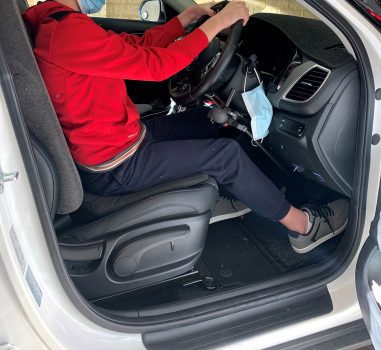 NDIS goals come in all shapes and sizes, and can include goals like travelling and moving around more independently – something that an occupational therapy driving assessment can help with.
NDIS goals come in all shapes and sizes, and can include goals like travelling and moving around more independently – something that an occupational therapy driving assessment can help with.
You may have a diagnosis that affects your ability to drive safely. This particular branch of OT focuses on supporting you, and finding ways to achieve your goal of getting behind the wheel again. This can include a range of different interventions such as:
- Evaluating your condition and capabilities
- Assessing your capacity to drive safely
- Prescribing car modifications to make it possible
Our Occupational Therapy Driving Service is led by Jen Blaxill, an experienced and registered driver trained occupational therapist based in our Perth clinic. Jen’s completed specialised post-graduate training so that she can conduct driving assessments, and for the past two years has worked exclusively in driving and vehicle modifications.
It isn’t just drivers, either. Some people living with disability may need support to travel as passengers in a car. If you fall into this category, Jen and the team can assess your needs and find ways to make using a car easier for you.
Here’s a glimpse into what she gets up to during a typical work day, as well as what an occupational therapy driving assessment might involve!
A day in the life: what our occupational therapy driving assessment specialists get up to
8:00am – 8:30am
I arrive at our Wembley clinic and gather some equipment for the day. I’m often working out on the road (no pun intended), meeting participants at their homes or in their local areas depending on their goals for driving. I’ve usually grabbed a coffee on my way in (thanks Workshop Espresso!) and use this time to answer emails, make appointments and follow up on any admin to make the day run smoothly.
8:30am – 11:00am
I head out to my first session of the day. This morning I’m meeting with a 17-year-old learner driver who has a diagnosis of autism and Attention Deficit Hyperactivity Disorder. He’s worked hard over the last semester, attending TAFE WA to complete a ‘Pre-Driver Education Skill Set’ course to learn the road rules and recently passed his theory test on the first try! His GP completed a Department of Transport medical certificate as part of the mandatory reporting of medical conditions for licence holders and recommended that he conduct an Occupational Therapy Driver Assessment to confirm his fitness to hold a learner’s permit.
We have two goals of the assessment today: firstly, determining his driving readiness, and secondly to draw up a plan with recommendations to support him to learn to drive safely and gain his provisional licence. We spend some time talking about his motivations to drive (in his words, “so I can get a girlfriend and we can go to the drive-in movies”), then conduct a review of his cognition and his physical function. A driving instructor comes to meet us halfway through, and we head into a very large empty car park for a driving lesson in a dual controlled vehicle – the perfect place for a new driver!
We have a special permit from the DoT to enable him to drive legally during the assessment and start off by introducing the vehicle controls and learning how to steer and use the pedals. We don’t leave the car park today, but I learn lots about his capacity to follow instructions, his visual observation habits, cognitive processing and coordination that indicates where he will need some extra support to learn the ropes of safe driving. Afterwards I have a chat with him and his family about my findings and recommend he complete some training with a Driver Trained OT followed by a series of specialised driver training lessons. We’re intending to apply to the NDIS to have this funded through his plan.
11:00am – 12:30pm
I hightail it to one of the vehicle modifier’s workshops to meet a participant who is picking up his newly modified vehicle today. He sustained a complete C5-C6 spinal injury about a year ago, which means he has no voluntary control or sensation in his lower body and lower trunk and some limitations in his wrist function.
Driving is a huge goal for him, enabling him to return to work and support his young family. We decided to put hand controls in his new car, enabling him to operate the brake and accelerator with his hands. He has a spinner knob to assist with one-handed steering, a folding transfer plate, some buttons on the hand control for the indicators and other switches, and a racing style harness to keep him nicely positioned in the seat around those fast corners and speed humps. We also need a way for him to get his wheelchair into the car independently and have gone with a robotic arm boot hoist that picks up the wheelchair from the driver’s side door and places it in the boot, all controlled by a switch on the dash. Complete independence!
This has been a few months in the making, with an initial assessment to determine his modification needs, driving lessons, vehicle hunting and an application to the NDIS for funding for the vehicle modifications — to the tune of about $50,000 excluding the vehicle. We make sure everything is working nicely with a test drive, make a couple of tweaks to the positioning of the hand control and watch him drive off independently for the first time since his injury. He calls me a couple of hours later to let me know he’s already tested out going through the drive-thru and couldn’t be more chuffed to be back on road.
12:30pm – 1pm
I head back to the office and grab some lunch. It’s a great opportunity to check in with the team and have a chat about whose lunch smells the best (my tuna salad is not making the cut).
1:00pm to 2:30pm
I’m in the office this afternoon, writing up my report from my morning participant – we’ll be sending this through to both DoT and the NDIS. While reports sometimes aren’t as ‘fun’ as being out on the road, they’re an important part of providing evidence to support participant medical reporting to DoT and to enable them to request the support they need through the NDIS.
2:30pm to 3:30pm
I jump into a supervision session on assistive technology with my Occupational Therapy colleagues from all over the country. We’ve all got our own areas of interest and expertise, so these supervision sessions allow us to bring questions and get advice. It’s a great opportunity to make sure we’re all staying up to date and sharing knowledge amongst the team.
3:30pm to 4:00pm
I follow up on a couple of emails and chat to a new referral – I speak with a Mum and Dad of a seven-year-old girl with cerebral palsy. They are ready to look at modifications to their vehicle to make sure she is safe in the car and to help with getting her wheelchair in. Currently they are manually lifting her into a specialised car seat, however she is growing very tall and mum is expecting baby number two, so we need to find another solution! I gather some information and book an appointment to go and see them next week. We’ll be reviewing their current car, home and wheelchair set up before shortlisting some possible solutions and booking in some trials – it’s always really valuable when we can test out equipment in person and for the family to be comfortable in their decision making.
4:00pm – 4:30pm
Almost at the end of the day, I make a call to a 63-year-old lady with early onset dementia. We recently did an assessment together with the outcome being that she was recommended to retire from driving due to concerns for her safety. Sometimes we need to make this recommendation, however our goal is always to support them with finding a way to get to the things they want and need to do. We’ve been working together to build her skills with using other transport options, particularly using the transport funding in her NDIS plan to catch a taxi to the shops. It has been an emotional journey navigating a change in independence, however today she shares with me how great it felt to get the taxi to the shops and buy her grandson a birthday gift, all on her own. Always great to end the day on a high note!
Is driving again one of your NDIS goals?
If so, you’ll need to start by arranging an occupational therapy driving assessment.
Our occupational therapists have experience supporting a range of NDIS goals, helping participants become more mobile and independent. Ability Action Australia is an NDIS provider in Perth that provides support for a range of different participants. In addition to occupational therapy driving support, we also offer functional capacity assessments, NDIS positive behaviour support, psychology, speech pathology, school leaver employment support, and exercise physiology in Perth. Based on your circumstances, we create tailored plans that support your needs and help you achieve your goals.
Learn more about driving assessments by reading our OT driving assessment FAQs.
Can’t find the answer to your specific question? Get in touch with our team directly by calling 1800 238 958, or by getting in touch online, and our friendly concierge team will answer your questions!

